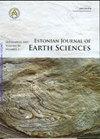奥陶纪辐射时期三叶虫向河口环境扩张
IF 0.8
4区 地球科学
Q4 GEOSCIENCES, MULTIDISCIPLINARY
引用次数: 0
摘要
传统上认为三叶虫完全是海洋生物。通过在层序地层学和地层古生物学框架内整合技术、古生物学和沉积学数据集,我们挑战了这一假设。本文基于对阿根廷西北部科迪勒拉东部地区的圣罗西塔组(Santa Rosita)的Furongian Tilcara段(TM)和最新的Furongian Pico de Halcón段(PHM)、晚期Tremadocian caronal组(CF)和dapingian - darriwillian Alto del Cóndor组(ACF)的切割河流河口河谷沉积的研究。这些山谷被切割成以波浪为主的浅海地层,并充满海侵沉积物,这些沉积物聚集在潮汐为主的河口。尽管TM缺乏三叶虫在河口环境中存在的任何尸体或痕迹化石证据,但其他三个单元表明三叶虫能够栖息在这些环境中。PHM和CF是河口外相三叶虫痕迹化石的宿主,都含有各种各样的Cruziana(如TM中的C. omanica和C. semiplicata)和Rusophycus(如两个单元中的R. latus)。此外,PHM中还含有阿根廷常见的olenid Neoparabolina三叶虫的体化石和中河口相化石。ACF在河口内、中、外沉积物中均发现了C. rugosa群三叶虫痕迹化石,说明其进一步向陆侵。据此,我们的资料表明,该单元曾两次尝试通过半咸淡水向陆地勘探:第1阶段,河口外至中部由olenids (furonian -晚tremadoian早期)占据;第2阶段,由asapids (Dapingian-Darriwilian)在河口内、中、外进行勘探。我们的研究表明,这些三叶虫能够耐受盐度胁迫,并能够利用边缘海洋环境提供的生态优势,沿着盐楔向河口上游迁移,要么反映两栖性,要么作为全盐性海洋流浪者。这表明,不同三叶虫群对盐度胁迫的耐受性是由于三叶虫在奥陶纪辐射期间的广泛行为和适应而独立产生的。我们推测,所有三叶虫都是窄盐虫的假设可能导致一些潮汐主导的河口沉积物被误解为完全是海相的。本文章由计算机程序翻译,如有差异,请以英文原文为准。
Trilobite expansion into estuarine environments during the Ordovician radiation
Trilobites have traditionally been considered fully marine. Through the integration of ichnological, palaeobiological and sedimentological datasets within a sequence-stratigraphic and strati - graphic palaeobiology framework, we challenge this assumption. This analysis is based on the study of incised fluvio-estuarine valley deposits from the Furongian Tilcara Member ( TM ) and the latest Furongian Pico de Halcón Member ( PHM ) of the Santa Rosita Formation, the early late Tremadocian Cardonal Formation ( CF ) , and the Dapingian–Darriwilian Alto del Cóndor Formation ( ACF ) , from Cordillera Oriental of northwest Argentina. These valleys were incised into wave-dominated shallow-marine strata and filled with transgressive deposits that accumulated in tide-dominated estuaries. Whereas the TM lacks any body or trace fossil evidence of the presence of trilobites in estuarine settings, the other three units reveal that trilobites were able to inhabit these settings. The PHM and CF are host to trilobite trace fossils in outer estuarine facies, both containing various ichnospecies of Cruziana (e.g., C. omanica and C. semiplicata in the TM ) and Rusophycus (e.g., R. latus in both units). In addition, the PHM also contains body fossils of the olenid trilobite Neoparabolina frequens argentina in the same deposits in which the trace fossils are preserved, as well as from middle estuarine facies. The ACF displays trilobite trace fossils of the C. rugosa group in inner, middle, and outer estuarine deposits, illustrating further landward incursions. This unit also contains body fossils of the asaphid trilobite Ogyginus sp. Accordingly, our data indicate two attempts of landward exploration via brackish water: phase 1 in which the outer to middle portion of estuaries were colonized by olenids ( Furongian–early late Tremadocian) and phase 2 involving exploration of the inner, middle, and outer es tuarine zones by asaphids ( Dapingian–Darriwilian). Our study indicates that these trilobites were tolerant to salinity stress and able to make use of the ecological advantages offered by marginal-marine environments migrating up-estuary, following salt wedges either reflecting amphidromy or as euryhaline marine wanderers. It is suggested that tolerance to salinity stress arose inde - pendently among different trilobite groups as a result of the broad array of behaviors and adaptations of trilobites during the Ordovician radiation. We speculate that the assumption that all trilobites were stenohaline may have resulted in the misinterpretation of some tide-dominated estuarine deposits as fully marine.
求助全文
通过发布文献求助,成功后即可免费获取论文全文。
去求助
来源期刊

Estonian Journal of Earth Sciences
地学-地球科学综合
CiteScore
1.50
自引率
9.10%
发文量
11
审稿时长
>12 weeks
期刊介绍:
The Estonian Journal of Earth Sciences is an international scientific open access journal published by the Estonian Academy of Sciences in collaboration with the Tallinn University of Technology, the University of Tartu, the Estonian University of Life Sciences and the Talllinn University.
The journal publishes primary research and review papers in the English language. All articles are provided with short Estonian summaries.
All papers to be published in the journal are peer reviewed internationally.
The journal is open for publications in all fields of Earth sciences, including besides different geological sensu lato disciplines, also geography and oceanography having certain connection with our part of the world, North Europe and the Baltic area in particular.
 求助内容:
求助内容: 应助结果提醒方式:
应助结果提醒方式:


